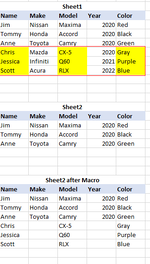Hello All.
I've been wrecking my brain for the past few days on how to write this vba script but it just wont come to me.
I have two worksheets in the same workbook. Sheet1 and Sheet2.
Sheet1 is consistently updated with new information and made available via Data Query . Sheet2 obtains its data from Sheet1, but Sheet2 is updated by my team. When Sheet1 is updated, it will contain the rows has already been copied to sheet 2. Therefore, I would like some help with a vba script that will compare a single column in Sheet1 (Column A) with a single column in Sheet2 (Column A). If the value does not exist, then I would like to copy specific cells from Sheet1 to Sheet2, for example, Columns A, C, E).
Unfortunately the code I have so far is pretty messy (I'm still learning vba) but if any help can be provided I'd appreciate it. I have attached a picture of the expected results.
Thanks so much in advance for your help!
I've been wrecking my brain for the past few days on how to write this vba script but it just wont come to me.
I have two worksheets in the same workbook. Sheet1 and Sheet2.
Sheet1 is consistently updated with new information and made available via Data Query . Sheet2 obtains its data from Sheet1, but Sheet2 is updated by my team. When Sheet1 is updated, it will contain the rows has already been copied to sheet 2. Therefore, I would like some help with a vba script that will compare a single column in Sheet1 (Column A) with a single column in Sheet2 (Column A). If the value does not exist, then I would like to copy specific cells from Sheet1 to Sheet2, for example, Columns A, C, E).
Unfortunately the code I have so far is pretty messy (I'm still learning vba) but if any help can be provided I'd appreciate it. I have attached a picture of the expected results.
Thanks so much in advance for your help!
VBA Code:
Sub CompareTwoColumns()
Dim col1 As Range
Dim col2 As Range
Dim prod1 As String
Dim prod2 As String
Dim lr As Long
Dim incol1 As Variant
Dim incol2 As Variant
Dim r As Long
Dim ws1 As Worksheet
Dim ws2 As Worksheet
Set ws1 = Sheets("Sheet1")
Set ws2 = Sheets("Sheet2")
Set col1 = Sheets("Sheet1").Columns("A")
Set col2 = Sheets("Sheet2").Columns("A")
lr = Columns("B:C").SpecialCells(xlCellTypeLastCell).Row
'Select first empty cell in column 2
With ws2
For Each cell In ws2.Columns(2).Cells
If IsEmpty(cell) = True Then cell.Select: Exit For
Next cell
End With
'Set empty cell variable
Dim nextcell As Range
Set nextcell = ActiveCell
With ws1
For r = 2 To lr
prod1 = Cells(r, col1.Column).Value
prod2 = Cells(r, col2.Column).Value
'check if prod1 is in col2
If prod1 <> "" Then
Set incol2 = col2.Find(prod1)
If incol2 Is Nothing Then
'Cells(r, col1.Column).Interior.Color = vbYellow
.Range(.Range("A2"), .Columns("A").Cells(.UsedRange.Rows(.UsedRange.Rows.Count).Row)).copy Destination:=nextcell
.Range(.Range("C2"), .Columns("C").Cells(.UsedRange.Rows(.UsedRange.Rows.Count).Row)).copy Destination:=nextcell.Offset(0, 2)
.Range(.Range("E2"), .Columns("E").Cells(.UsedRange.Rows(.UsedRange.Rows.Count).Row)).copy Destination:=nextcell.Offset(0, 4)
End If
End If
Next
End With
End Sub





